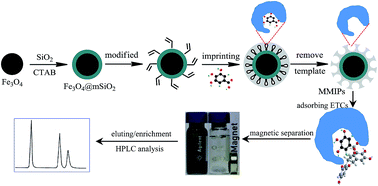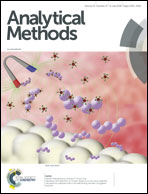Magnetic surface molecularly imprinted polymeric microspheres using gallic acid as a segment template for excellent recognition of ester catechins
Abstract
Magnetic surface molecularly imprinted polymeric microspheres (MMIPs) were prepared by using gallic acid (GA) as a segment template for the solid extraction of ester catechins as a whole from complex samples. MMIPs were characterized by Fourier transform infrared spectroscopy, transmission electron microscopy, and vibrating sample magnetometry. The results of the adsorption experiments indicated that the saturated adsorption capacity of GA on MMIPs was 0.21 mmol g−1, and the imprinting factor was 5.86; MMIPs had higher adsorption capacity for ester catechins than benzoic acid, salicylic acid, and 2,4-dihydroxybenzoic acid. The adsorption process of MMIPs could be better described by pseudo secondary rate equation, and it was consistent with the Langmuir adsorption model. In addition to GA, MMIPs could selectively recognize ester catechins in a tea solution without column packing. Thus, MMIPs prepared using GA as a segment template can be used in selective separation and enrichment of ester catechins from tea samples for functional food production.

- This article is part of the themed collection: Analytical Methods Recent HOT articles


 Please wait while we load your content...
Please wait while we load your content...